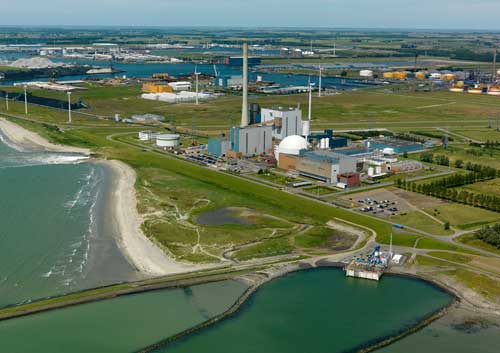
FIRST MOX LOADING IN BORSSELE
During its annual refueling outage in June 2014, the Borssele reactor (the only commercial nuclear power plant in The Netherlands) was for the first time partially loaded with MOX fuel. This marks the completion of the “Fuel Diversification Project” that was publicly announced by EPZ, Borssele’s owner-operator, in May 2008. The end result will be that the Borssele reactor will have a fully-closed fuel cycle with the possibility of 40 per cent of its fuel being MOX.

In previous years, EPZ continued its practice of fuel reprocessing until the final core, which is scheduled for unloading in 2034 when the reactor’s 60 years lifetime expires. In the past, the plutonium separated from Borssele fuel by Areva’s La Hague treatment plant had been used to fabricate MOX fuel for foreign reactors. In 2008, EPZ announced that it wanted to have the possibility of loading MOX into its Borssele reactor (called ‘fuel diversification’), and EPZ initiated a license application process. Because Borssele has been using recycled uranium for many years, this means that the fuel cycle, for the uranium as well as for plutonium, is completely closed.
The licensing procedure was a protracted one, challenged in court by some NGO’s. But in 2013, the license to load MOX in Borssele became irrevocable and MOX fabrication for Borssele was finally able to start. EPZ contracted Areva for the MOX fabrication at their MELOX plant in the south of France. The first MOX assemblies were delivered in December 2013 and the first 8 were loaded into the Borssele reactor in June 2014. These are the “pathfinder” assemblies required by the nuclear license. If these “pathfinders” perform well during the first fuel cycle, EPZ can continue to annually load 12 MOX assemblies when profitable until, in equilibrium, 48 out of 121 assemblies (40 per cent) are MOX. The balance of the reactor (60 per cent) is made of enriched natural uranium or enriched recycled uranium. After reaching its target burn-up, all used fuel (including the MOX) will be sent to La Hague for treatment.

The advantage of the closed fuel cycle is that after 60 years of reactor operations only one type of high-level waste (vitrified residues) is left to manage, and there is no plutonium or spent fuel. The vitrified residues are stored by the government-owned COVRA organization for at least 100 years prior to geological disposal in the Netherlands. This back-end solution is a well-established element of Dutch national policy. In November 2013, King Willem-Alexander of the Netherlands signed the Ratification Act concerning Dutch-French cooperation in fuel recycling, and this Act has passed through Parliament.
There is a catch, however. The final core of the Borssele reactor, in 2034, will also contain plutonium that will become available after treatment in La Hague, but which cannot be transferred to the Netherlands. As a solution, EPZ and Areva agreed on a “pre-cycling” scheme. The plutonium needed to fabricate the MOX for Borssele is presently “loaned” by Areva; in the future when EPZ’s plutonium is being reclaimed in La Hague, that plutonium will be transferred back to Areva as re-imbursement. The net result will be that EPZ will, in the end, have no plutonium left to manage.

|

